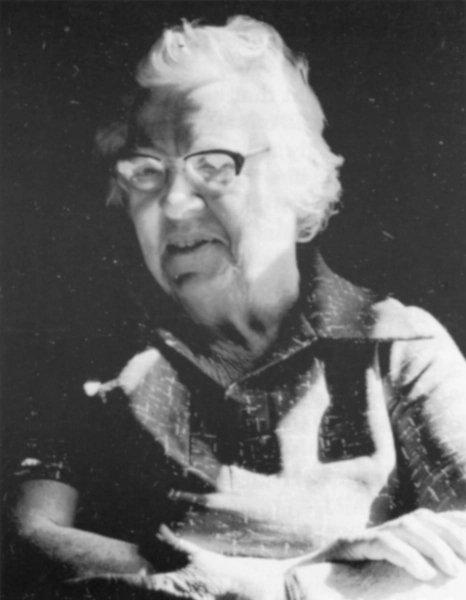Margaret Gralton
Biography

Margaret Gralton (née Scollan) was born on 11 June 1911 in the townland of Corlisheen, County Leitrim, Ireland. She was the daughter of Patrick Scollan, a local farmer, and Bridget Scollan (née Gilhooly). Gralton grew up in rural Leitrim during a period of great social change, coming of age just after Ireland’s revolutionary era. Little is recorded about her formal schooling, but she was educated in her local community, where she developed a deep appreciation for history and rural Irish life. Notably, Margaret was a cousin of the socialist leader Jimmy Gralton – her maternal grandmother was a sister of Jimmy’s mother. This family connection to one of Ireland’s most prominent left-wing figures would profoundly shape her worldview.
Marriage and Personal Life
In 1934, Margaret Scollan married Patrick “Packie” Gralton at the Roman Catholic Church in Drumsna, County Leitrim. The union further entwined her life with Jimmy Gralton’s legacy: Packie Gralton was himself a relative of Jimmy’s on the paternal side. Both Margaret and her husband shared strong socialist convictions, and local lore recounts that they faced opposition from clergy when marrying due to their association with Jimmy’s socialist activities. After their marriage, the couple took up residence in Jimmy Gralton’s old homestead in Effernagh (near Gowel, Co. Leitrim). There, they cared for Jimmy’s aging mother, Alice, who lived with them until her health declined in later years. Margaret and Packie’s home effectively became a living link to Jimmy Gralton’s memory, and they ensured that his immediate family was looked after with compassion. The couple had a family of their own; for example, their son, James (“Jim”) Gralton, later recalled how his parents had personally witnessed Jimmy’s dramatic deportation from Ireland in 1933.
Political and Community Involvement
Gralton remained deeply involved in local political and cultural life in County Leitrim throughout her years. She and her husband were lifelong socialists, and Packie had even been a member of Jimmy Gralton’s Revolutionary Workers’ Group in the 1930s – the precursor to the Communist Party of Ireland. Margaret herself became a dedicated member of the Labour movement. She served as President of the South Leitrim Branch of the Irish Labour Party, using this role to champion workers’ rights and rural social issues at a grassroots level. Gralton was known for her outspoken advocacy of socialist principles, which in the conservative mid-20th century rural Ireland often put her at odds with establishment figures, particularly within the Church. Despite this, she earned widespread respect for her integrity and perseverance. In 1986, as public recognition of Jimmy Gralton’s story began to grow once more, Margaret (then in her mid-70s) and Packie were among the founding members of the Gralton Labour History Commemorative Committee, which organized annual events to honor Jimmy’s legacy. Decades after Jimmy’s deportation, the Graltons’ home in Effernagh became a gathering place for activists, historians, and politicians seeking to commemorate and learn from his life. Local leaders and national figures alike valued Margaret Gralton’s eyewitness accounts and passionate speeches at these commemorations. Her unwavering commitment to socialist ideals and community welfare made her a well-known figure in Leitrim’s public life well into her later years.
Writing and Local History Work
In addition to her political activism, Margaret Gralton made significant contributions as an author and local historian. She was a keen documentarian of Leitrim’s history and of the folk memory surrounding her cousin Jimmy. Gralton’s best-known publication is My Cousin Jimmy (1991), a biographical booklet she wrote about Jimmy Gralton’s life. Published by Drumlin Publications in County Leitrim, this 56-page illustrated work offers a personal recounting of Jimmy’s story as seen through Margaret’s eyes. My Cousin Jimmy is regarded as an invaluable first-hand narrative of the only Irishman deported from his own country without trial, providing insights into Jimmy Gralton’s character and the local context of the 1920s–1930s. The book, though modest in length, is rich in family and community lore, reflecting Margaret’s intimate knowledge of events and her nuanced understanding of the political climate. It has been cited alongside works by Des Guckian and Pat Feeley as one of the key sources on Jimmy Gralton’s life, distinguished by the familial anecdotes and personal perspective that Margaret contributed.
Gralton was also a regular contributor to the Leitrim Guardian, an annual periodical devoted to the county’s heritage and people. Over the years she penned numerous articles sharing local history, personal memoirs, and cultural commentary. For instance, in the 1998 edition of Leitrim Guardian (Vol. 30), she published an article entitled “The Big Apple Seventy Years Ago,” reminiscing about life in New York City as experienced by Leitrim emigrants in the late 1920s. Her writing often drew on her own experiences; notably, at one point in the 1930s she herself visited Jimmy during his exile in New York, and later wrote of his longing to return to Ireland. Readers of the Leitrim Guardian came to appreciate Gralton’s engaging storytelling style, which blended historical facts with vivid recollections of rural Irish life and the immigrant experience. She had a gift for preserving oral history: capturing the voices of ordinary people, the atmosphere of old Irish dances, or the hardships of the Land Commission era in her prose. Many of her pieces served to keep local history alive for younger generations, and she frequently emphasized themes of social justice and community solidarity in her writing.
Gralton’s final known publication, fittingly titled “Old Times,” appeared in 1998 in the journal Carrick-on-Shannon Remembered, published by the Carrick-on-Shannon & District Historical Society. In this reflective article, she recounted her early 20th-century childhood memories and the bygone customs of County Leitrim – once again framing her personal story within the wider social history of the area. “Old Times” was, in essence, the capstone of her work as a local historian: written when she was 87, it combined her nostalgia for the past with the clear-eyed perspective of someone who had witnessed nearly the entire span of independent Ireland. This piece, like much of her writing, preserved valuable details about daily life in Leitrim and offered a cousin’s insight into the youthful days of Jimmy Gralton. In addition to her own publications, Margaret Gralton was known to assist other researchers and journalists; for example, she gave interviews (recorded in 1991) about the “South Leitrim Soviet” and the Gralton affair, ensuring that the nuances of local left-wing activism were recorded for posterity. Her dedication to recording history earned her recognition among Irish historians and in Labour history circles as a credible and important witness to the events she described.
Later Years and Legacy
Margaret Gralton remained active in both political and cultural spheres into her later years. Even as an octogenarian she could be found attending historical society meetings, Labour Party gatherings, and commemorative events in County Leitrim. She was noted for her sharp memory and her undiminished passion when speaking about social justice or recalling the lively community gatherings at Jimmy’s Pearse-Connolly Hall. Locally, Gralton became something of a revered elder stateswoman: younger activists, writers, and students sought her out for her first-hand knowledge of Leitrim’s past. In the 1990s, renewed interest in Jimmy Gralton – including a radio documentary and plans for a film – brought Margaret back into the public eye, and she was consulted by filmmakers and journalists researching the period. The integrity of her recollections, rooted in family and community, provided a human dimension to historical accounts of 1930s Ireland.
In recognition of her contributions, the Labour movement in Leitrim honored Gralton for her lifetime of service, and the local historical society similarly acknowledged her role in preserving the county’s heritage. In her final year, despite failing health, she saw her last article published and continued to correspond with friends and colleagues about history and politics. Margaret Gralton passed away on 24 October 1998 at St. Patrick’s Hospital in Carrick-on-Shannon, County Leitrim. She was 87 years old. Her funeral took place in Jamestown, where she was laid to rest in the cemetery of Jamestown Abbey, not far from the landscapes she had known all her life.
Gralton’s legacy endures in County Leitrim and beyond. Her writings – from My Cousin Jimmy to her many articles – continue to be cited by historians and cherished by locals. Through these works, she ensured that the story of Jimmy Gralton and the spirit of the community that supported him would not be forgotten. Moreover, her own life stands as an example of quiet resilience and commitment to principles: she was a farmer’s daughter turned local historian who never wavered in her belief that ordinary people’s stories matter in the grand tapestry of history. In 2016, when a monument to Jimmy Gralton was finally unveiled by the President of Ireland in Effernagh, speakers paid tribute not only to Jimmy but also to those like Margaret who had kept his memory alive through the decades. In the annals of Leitrim’s history, Margaret Gralton is remembered as an author, historian, and activist who devoted her long life to her community and to the ideals of social justice.
Selected Publications
- My Cousin Jimmy (Drumlin Publications, 1991) – A 56-page illustrated biographical booklet about James “Jimmy” Gralton, providing a personal family perspective on the life of the socialist leader.
- “The Big Apple Seventy Years Ago” Leitrim Guardian, vol. 30 (1998), pp. 33–35 – Article reminiscing about Irish emigrant life in New York City in the late 1920s, based on Gralton’s own memories and family stories.
- “Old Times” Carrick-on-Shannon Remembered, vol. 1 (1998), pp. 41–43 – Memoir piece in the Carrick-on-Shannon & District Historical Society journal, recounting Gralton’s childhood in County Leitrim and reflections on local life in the early 20th century.
Works
- My Cousin Jimmy (1991)
- Beside the Golden Door [essay] (1993)
- Boarding in Carrick 66 Years Ago [essay] (1995)
- The Big Apple Seventy Years Ago [essay] (1998)
- Old Times [essay] (1998)
References
- Barton, R. (2016). Jimmy’s Hall, Irish Cinema and the Telling of History. Review of Irish Studies in Europe, 1(1), 93–106. https://doi.org/10.32803/rise.v1i1.1261
- Faughnan, B. (2022). Young historian awards: A transition year programme for students to investigate the history on their doorstep. Jimmy Gralton: deported without trial. https://www.younghistorian.ie/2022-winner
- Jimmy’s Hall Press Kit. (2014). https://medias.unifrance.org/medias/75/17/135499/presse/jimmy-s-hall-presskit-english.pdf
- Leitrim Observer. (2016, September 1). Large Numbers Expected for Gralton Unveiling. Retrieved May 29, 2025, from https://www.leitrimobserver.ie/news/home/214575/x-x.html
